Input interpretation

Ba(NO_3)_2 barium nitrate ⟶ O_2 oxygen + NO_2 nitrogen dioxide + BaO barium oxide
Balanced equation
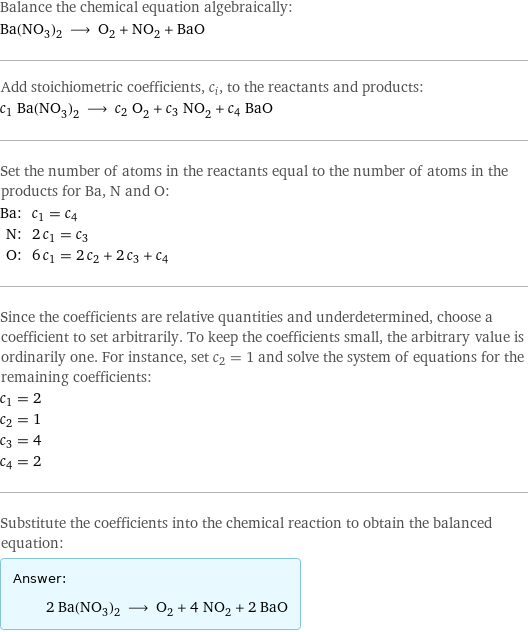
Balance the chemical equation algebraically: Ba(NO_3)_2 ⟶ O_2 + NO_2 + BaO Add stoichiometric coefficients, c_i, to the reactants and products: c_1 Ba(NO_3)_2 ⟶ c_2 O_2 + c_3 NO_2 + c_4 BaO Set the number of atoms in the reactants equal to the number of atoms in the products for Ba, N and O: Ba: | c_1 = c_4 N: | 2 c_1 = c_3 O: | 6 c_1 = 2 c_2 + 2 c_3 + c_4 Since the coefficients are relative quantities and underdetermined, choose a coefficient to set arbitrarily. To keep the coefficients small, the arbitrary value is ordinarily one. For instance, set c_2 = 1 and solve the system of equations for the remaining coefficients: c_1 = 2 c_2 = 1 c_3 = 4 c_4 = 2 Substitute the coefficients into the chemical reaction to obtain the balanced equation: Answer: | | 2 Ba(NO_3)_2 ⟶ O_2 + 4 NO_2 + 2 BaO
Structures
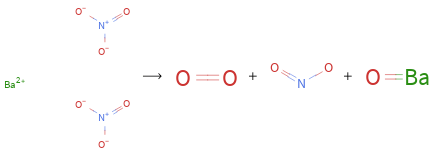
⟶ + +
Names

barium nitrate ⟶ oxygen + nitrogen dioxide + barium oxide
Reaction thermodynamics
Enthalpy
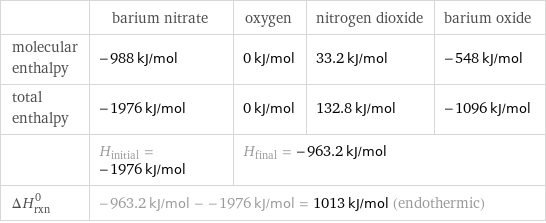
| barium nitrate | oxygen | nitrogen dioxide | barium oxide molecular enthalpy | -988 kJ/mol | 0 kJ/mol | 33.2 kJ/mol | -548 kJ/mol total enthalpy | -1976 kJ/mol | 0 kJ/mol | 132.8 kJ/mol | -1096 kJ/mol | H_initial = -1976 kJ/mol | H_final = -963.2 kJ/mol | | ΔH_rxn^0 | -963.2 kJ/mol - -1976 kJ/mol = 1013 kJ/mol (endothermic) | | |
Gibbs free energy
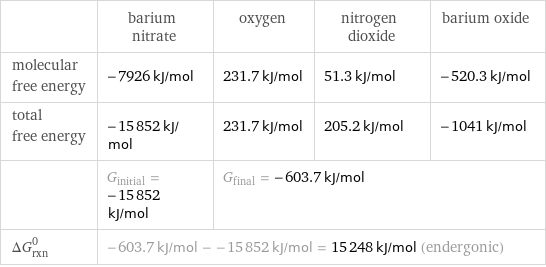
| barium nitrate | oxygen | nitrogen dioxide | barium oxide molecular free energy | -7926 kJ/mol | 231.7 kJ/mol | 51.3 kJ/mol | -520.3 kJ/mol total free energy | -15852 kJ/mol | 231.7 kJ/mol | 205.2 kJ/mol | -1041 kJ/mol | G_initial = -15852 kJ/mol | G_final = -603.7 kJ/mol | | ΔG_rxn^0 | -603.7 kJ/mol - -15852 kJ/mol = 15248 kJ/mol (endergonic) | | |
Equilibrium constant
![Construct the equilibrium constant, K, expression for: Ba(NO_3)_2 ⟶ O_2 + NO_2 + BaO Plan: • Balance the chemical equation. • Determine the stoichiometric numbers. • Assemble the activity expression for each chemical species. • Use the activity expressions to build the equilibrium constant expression. Write the balanced chemical equation: 2 Ba(NO_3)_2 ⟶ O_2 + 4 NO_2 + 2 BaO Assign stoichiometric numbers, ν_i, using the stoichiometric coefficients, c_i, from the balanced chemical equation in the following manner: ν_i = -c_i for reactants and ν_i = c_i for products: chemical species | c_i | ν_i Ba(NO_3)_2 | 2 | -2 O_2 | 1 | 1 NO_2 | 4 | 4 BaO | 2 | 2 Assemble the activity expressions accounting for the state of matter and ν_i: chemical species | c_i | ν_i | activity expression Ba(NO_3)_2 | 2 | -2 | ([Ba(NO3)2])^(-2) O_2 | 1 | 1 | [O2] NO_2 | 4 | 4 | ([NO2])^4 BaO | 2 | 2 | ([BaO])^2 The equilibrium constant symbol in the concentration basis is: K_c Mulitply the activity expressions to arrive at the K_c expression: Answer: | | K_c = ([Ba(NO3)2])^(-2) [O2] ([NO2])^4 ([BaO])^2 = ([O2] ([NO2])^4 ([BaO])^2)/([Ba(NO3)2])^2](../image_source/b61b68d5bc19e196ba7caa12b1536ec6.png)
Construct the equilibrium constant, K, expression for: Ba(NO_3)_2 ⟶ O_2 + NO_2 + BaO Plan: • Balance the chemical equation. • Determine the stoichiometric numbers. • Assemble the activity expression for each chemical species. • Use the activity expressions to build the equilibrium constant expression. Write the balanced chemical equation: 2 Ba(NO_3)_2 ⟶ O_2 + 4 NO_2 + 2 BaO Assign stoichiometric numbers, ν_i, using the stoichiometric coefficients, c_i, from the balanced chemical equation in the following manner: ν_i = -c_i for reactants and ν_i = c_i for products: chemical species | c_i | ν_i Ba(NO_3)_2 | 2 | -2 O_2 | 1 | 1 NO_2 | 4 | 4 BaO | 2 | 2 Assemble the activity expressions accounting for the state of matter and ν_i: chemical species | c_i | ν_i | activity expression Ba(NO_3)_2 | 2 | -2 | ([Ba(NO3)2])^(-2) O_2 | 1 | 1 | [O2] NO_2 | 4 | 4 | ([NO2])^4 BaO | 2 | 2 | ([BaO])^2 The equilibrium constant symbol in the concentration basis is: K_c Mulitply the activity expressions to arrive at the K_c expression: Answer: | | K_c = ([Ba(NO3)2])^(-2) [O2] ([NO2])^4 ([BaO])^2 = ([O2] ([NO2])^4 ([BaO])^2)/([Ba(NO3)2])^2
Rate of reaction
![Construct the rate of reaction expression for: Ba(NO_3)_2 ⟶ O_2 + NO_2 + BaO Plan: • Balance the chemical equation. • Determine the stoichiometric numbers. • Assemble the rate term for each chemical species. • Write the rate of reaction expression. Write the balanced chemical equation: 2 Ba(NO_3)_2 ⟶ O_2 + 4 NO_2 + 2 BaO Assign stoichiometric numbers, ν_i, using the stoichiometric coefficients, c_i, from the balanced chemical equation in the following manner: ν_i = -c_i for reactants and ν_i = c_i for products: chemical species | c_i | ν_i Ba(NO_3)_2 | 2 | -2 O_2 | 1 | 1 NO_2 | 4 | 4 BaO | 2 | 2 The rate term for each chemical species, B_i, is 1/ν_i(Δ[B_i])/(Δt) where [B_i] is the amount concentration and t is time: chemical species | c_i | ν_i | rate term Ba(NO_3)_2 | 2 | -2 | -1/2 (Δ[Ba(NO3)2])/(Δt) O_2 | 1 | 1 | (Δ[O2])/(Δt) NO_2 | 4 | 4 | 1/4 (Δ[NO2])/(Δt) BaO | 2 | 2 | 1/2 (Δ[BaO])/(Δt) (for infinitesimal rate of change, replace Δ with d) Set the rate terms equal to each other to arrive at the rate expression: Answer: | | rate = -1/2 (Δ[Ba(NO3)2])/(Δt) = (Δ[O2])/(Δt) = 1/4 (Δ[NO2])/(Δt) = 1/2 (Δ[BaO])/(Δt) (assuming constant volume and no accumulation of intermediates or side products)](../image_source/b65cf53a27690243e2350881575657d3.png)
Construct the rate of reaction expression for: Ba(NO_3)_2 ⟶ O_2 + NO_2 + BaO Plan: • Balance the chemical equation. • Determine the stoichiometric numbers. • Assemble the rate term for each chemical species. • Write the rate of reaction expression. Write the balanced chemical equation: 2 Ba(NO_3)_2 ⟶ O_2 + 4 NO_2 + 2 BaO Assign stoichiometric numbers, ν_i, using the stoichiometric coefficients, c_i, from the balanced chemical equation in the following manner: ν_i = -c_i for reactants and ν_i = c_i for products: chemical species | c_i | ν_i Ba(NO_3)_2 | 2 | -2 O_2 | 1 | 1 NO_2 | 4 | 4 BaO | 2 | 2 The rate term for each chemical species, B_i, is 1/ν_i(Δ[B_i])/(Δt) where [B_i] is the amount concentration and t is time: chemical species | c_i | ν_i | rate term Ba(NO_3)_2 | 2 | -2 | -1/2 (Δ[Ba(NO3)2])/(Δt) O_2 | 1 | 1 | (Δ[O2])/(Δt) NO_2 | 4 | 4 | 1/4 (Δ[NO2])/(Δt) BaO | 2 | 2 | 1/2 (Δ[BaO])/(Δt) (for infinitesimal rate of change, replace Δ with d) Set the rate terms equal to each other to arrive at the rate expression: Answer: | | rate = -1/2 (Δ[Ba(NO3)2])/(Δt) = (Δ[O2])/(Δt) = 1/4 (Δ[NO2])/(Δt) = 1/2 (Δ[BaO])/(Δt) (assuming constant volume and no accumulation of intermediates or side products)
Chemical names and formulas
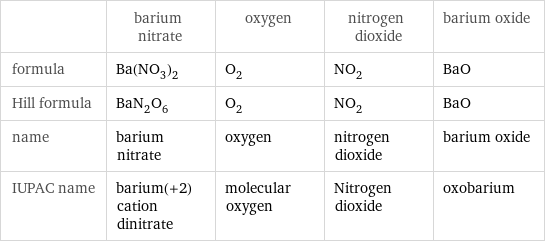
| barium nitrate | oxygen | nitrogen dioxide | barium oxide formula | Ba(NO_3)_2 | O_2 | NO_2 | BaO Hill formula | BaN_2O_6 | O_2 | NO_2 | BaO name | barium nitrate | oxygen | nitrogen dioxide | barium oxide IUPAC name | barium(+2) cation dinitrate | molecular oxygen | Nitrogen dioxide | oxobarium
Substance properties
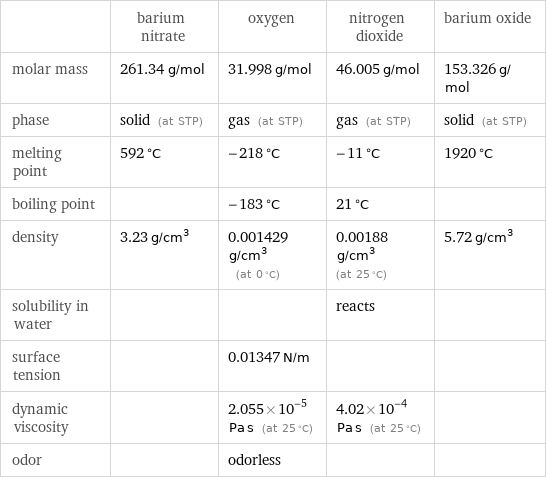
| barium nitrate | oxygen | nitrogen dioxide | barium oxide molar mass | 261.34 g/mol | 31.998 g/mol | 46.005 g/mol | 153.326 g/mol phase | solid (at STP) | gas (at STP) | gas (at STP) | solid (at STP) melting point | 592 °C | -218 °C | -11 °C | 1920 °C boiling point | | -183 °C | 21 °C | density | 3.23 g/cm^3 | 0.001429 g/cm^3 (at 0 °C) | 0.00188 g/cm^3 (at 25 °C) | 5.72 g/cm^3 solubility in water | | | reacts | surface tension | | 0.01347 N/m | | dynamic viscosity | | 2.055×10^-5 Pa s (at 25 °C) | 4.02×10^-4 Pa s (at 25 °C) | odor | | odorless | |
Units
